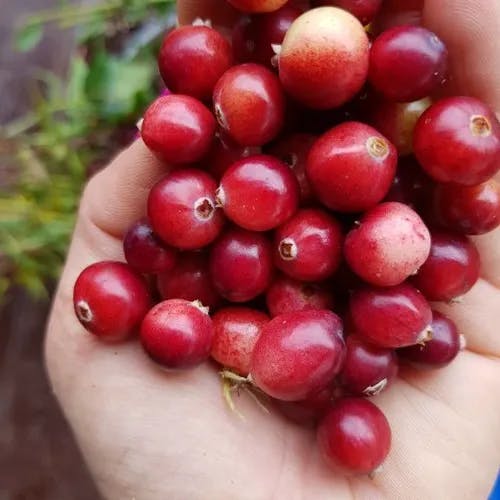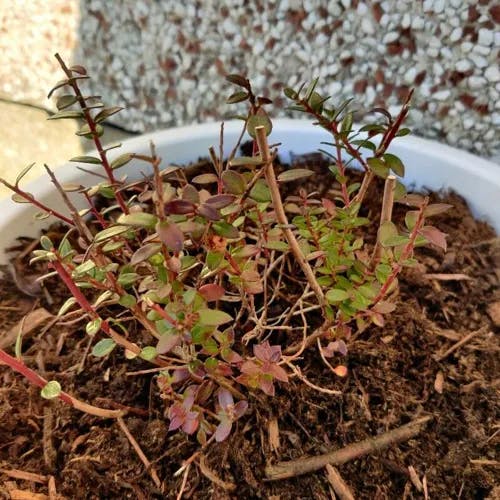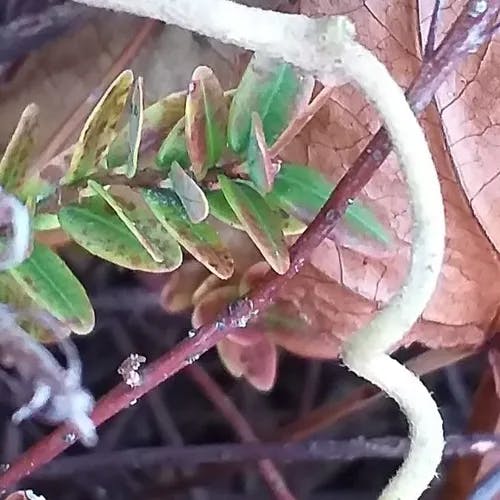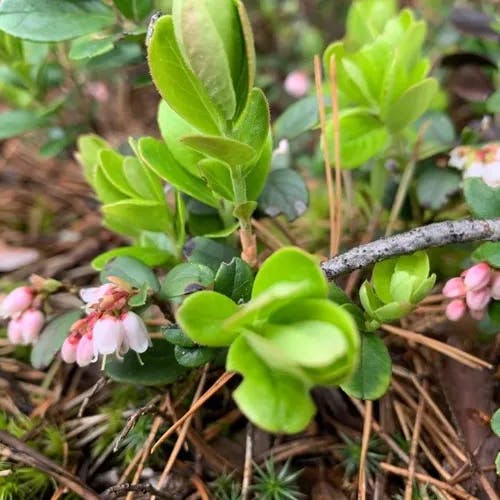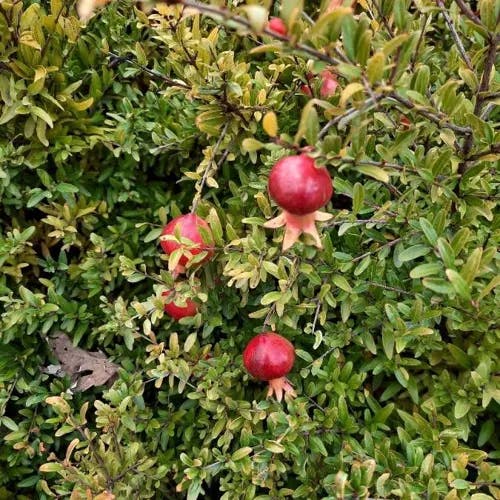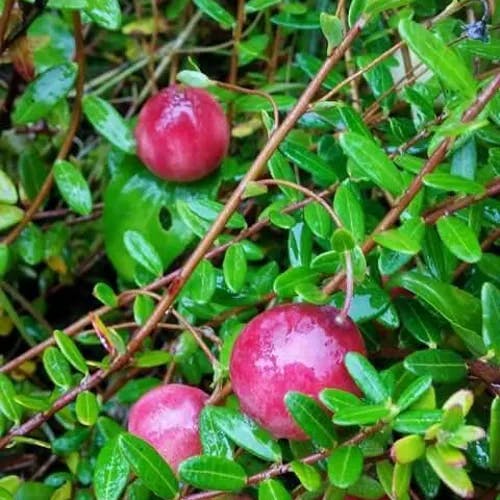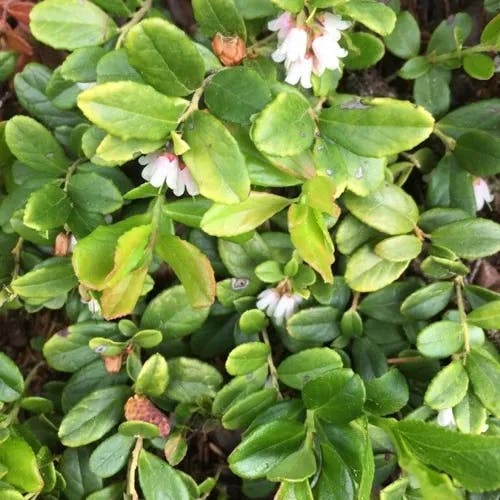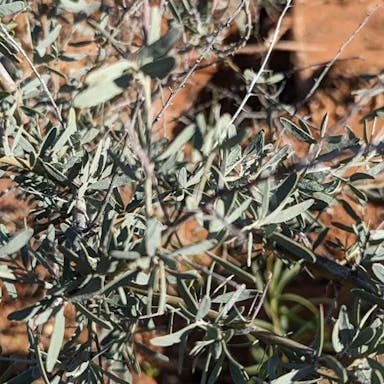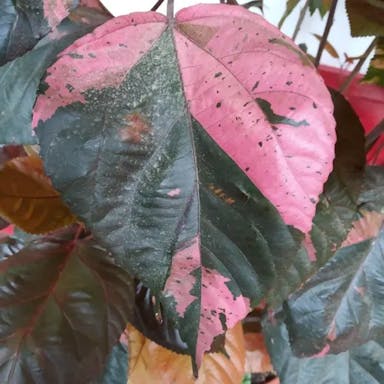The crimson berries of this short, creeping plant are traditionally served as a condiment at harvest festivals. Its trailing branches and little oval leaves flourish in wet areas. Blossoms resembling a bird's head open in the spring. Juice from the fruits can help prevent certain infections. This hardy shrub thrives in cool climates and needs abundant moisture. It earned its name from the resemblance of its flowers to the beak and neck of a crane. The plants grow well when planted together in boggy areas for commercial use. They require acidic soil and sunlight. The berries can be quite tart until fully ripe in late summer. Their bright red color and tangy flavor make them ideal for sauces, desserts, and drinks. This species is native to northeastern North America.
American cranberry
- Scientific name
- Vaccinium macrocarpon
Basic Information
- Ericaceae Family Vaccinium Genus American cranberry Species
- Ericaceae > Vaccinium > Vaccinium macrocarpon
- 83%
- The Completeness of This Encyclopedia
Please help us complete the encyclopedia, Terrarium is a encyclopedia service to be completed with everyone in the world. Currently, this page is 83% complete. For more information on how to contribute, please click here.
- Shrub
- Height
- 10cm ~ 20cm
- Flower Color
- Leaf Color
- Anthesis
- spring, summer
- Sunlight Exposure
Full Sun Long hours of sunlight from morning to afternoon Partial Shade A location in the shade of a tree or where either the morning or afternoon is shaded Full Shade A place where there is no direct sunlight
- Full Sun
- Hardiness Zones
This is an indicator to know to which zone each plant can winter. Knowing the zone of each plant gives you an idea of the cold temperature resistance when grown in the ground without a roof. 2: -42.7 to -40.0 3: -39.9 to -34.4 4: -34.3 to -28.9 5: -28.8 to -23.3 6: -23.2 to -17.8 7: -17.7 to -12.2 8: -12.1 to -6.7 9: -6.6 to -1.1 10: -1.0 to 4.4 11: 4.5 to 10.0
- 3-9
- Cold resistance
- Excellent
- Heat resistance
- Fair
- Habitat of origin
- United States
- Growth Rate
- Normal
What is American cranberry (Vaccinium macrocarpon)?
What is American cranberry (Vaccinium macrocarpon)
Flower meaning
The American cranberry plant, whose scientific name is Vaccinium macrocarpon, is frequently linked with the coded meanings in floriography of
Calendar of American cranberry (Vaccinium macrocarpon)
Calendar
The American cranberry's flowering time spans late spring through early summer, roughly May to June in the United States. Pinkish-white blossoms burst forth, presenting a vibrant floral display for 1-2 weeks depending on climate and weather. To extend this flowering period, keep soil moist and well-drained with regular watering during dry times. Applying balanced, slow-release fertilizer in early spring supports abundant blooms. However, avoid over-fertilizing, as that causes excessive foliage instead of flowers. Note that flowering times vary by region and environment.
How to grow American cranberry (Vaccinium macrocarpon)
Watering
The American cranberry plant, also known by its scientific name Vaccinium macrocarpon, thrives optimally when the surrounding dirt that it grows in has a pH level ranging between four point zero and five point five. This dirt should drain well and not collect water. During the main growing season of this plant, which is usually April until September depending on location, the cranberry plant should be given water every two to three days, adjusting for weather conditions. Hot and dry periods call for daily watering while dormant cold seasons only need watering once every four to five days. Ideal water amounts are one to two inches per week, factoring in natural rainfall. Sprinklers overhead can protect against frost in cold months. Remember that cranberries originate from wet areas but cannot sit in soaked ground. Check dirt wetness routinely to enable best growth.
Soil and Fertilizer
The shrub Vaccinium macrocarpon, also identified as the North American cranberry, does well in suitably-drained, acidic ground with a pH range of 4.0 to 5.5. The dirt should be abundant in natural material, and sandy or peat soils are ideal. Manure request should be fulfilled in initial springtime, just anterior to juvenile growth inaugurates. A counterpoised manure, such as a 10-10-10 (N-P-K) recipe, is suggested. Administer approximately 1 pound of manure per 100 square feet of cranberry bed. Manure should be administered again in earlyish summertime, ensuing the identical guidelines. Refrain from over-manuring as it begets inordinate vegetative increment at the disbursement of fruit creation. Soil examining is suggested to regulate circumstantial nutrient requests and adapt manure request therefore. Sustaining decorous soil wetness is also crucial for the wellbeing and yield of the sprout. Remember, cranberries are conformed to impoverished ripeness dirts, so less is frequently more when it approaches fertilisation.
Sunlight and Place
The optimal vegetation for the fruity plant thrives in ample sunlight or incomplete shade. It necessitates a baseline of 6 hours of daylight each date for peak evolution. The bush is cold-staunch and can make it through in thermometers as depressed as -40 positions Fahrenheit scale. Though, it chooses a chillier mood and does not put up with emotional warmth fine. During the fall, Vaccinium macrocarpon needs to be situated in a whereabouts where it can invite forenoon sunlight and posterior shade to obstruct overcooking. In winter, it can put up with ample sunlight vulnerability. The bush is not expressly hale in sunlight, so it should be sheltered from strong noonday sunlight. The ideal heat for Vaccinium macrocarpon is amid 60 and 70 positions Fahrenheit scale. It is consequential to annotation that while the bush can tolerate a area of illumination stipulations, it will spawn the premium fruit in ample sunlight.
Advanced Information of American cranberry (Vaccinium macrocarpon)
Pruning
The American cranberry, with the scientific name Vaccinium macrocarpon, only requires minimal trimming. Pruning is essential to take away expired or sick divisions, help air flow, and stimulate new expansion. The most favorable time period for pruning is early on in springtime before the onset of new growth, however after the threat of utmost cold has bypassed. Upon pruning, operate pointy, sanitized tools to create neat cuts at a 45-degree point, precisely over a bud or arm. Eliminate no greater than one-third of the greenery at a stretch to evade pressuring the greenery. Subsequent to pruning, dispense a counterpoised fertilizer to support novel expansion and irrigate thoroughly. Observe the greenery for indicators of affliction or pest action, as pruning can occasionally render greenery additional prone. Remember, over-pruning may lead to reduced yield manufacture, thus it's most favorable to prune sparingly.
Planting and Harvest
The American cranberry, which also goes by the name Vaccinium macrocarpon, can be cultivated in containers or directly in the ground. For container-grown plants, select a pot with good drainage and pack it with a mixture of peat moss, sand, and loamy earth. Fix the cranberry shrub at the center of the pot, making certain the crown is level with the top of the soil. Give water on a regular basis but steer clear of overwatering, as cranberries like well-drained earth. For transplanting, opt for a more capacious container and tenderly extract the plant from its current pot. Situate it in the new container, fill up with soil, and thoroughly water. In terms of climate, cranberries call for full sunlight to partial shade and cool temps. They also necessitate acidic ground with a pH of 4.0 to 5.0. Whether grown in containers or the ground, cranberries have similar care requirements and preferences. However, container-grown plants may need more frequent irrigation due to faster drying of the soil.
Propagation
The American fruits Vaccinium macrocarpon propagate by grafting, layering, and slips. To multiply by shoots, select a vigorous twig and clip a four-six centimeter area. Wipe the base with our juice, and implant into a container with loose minimalistic dirt. Provide sodium vapor lamps and nurture the pot in a shaded spot. Bending implies bowing a short division to the floor, bedecking an area with gravel, and keeping in place with a block or peg. Eventually, this portion will evolve roots and can part from the forebear sapling to shape a novel one. For seed augmentation, congregate ripe berries and cull the pits. Sanitize and dehydrate them preceding sowing into a slack soil mixture. Maintain the earth damp and render a glacial stratification epoch of roughly three moons for origination. Compilation of fruits generally befalls in autumn when they are profound crimson in pigment.
Pests and Diseases
The plant Vaccinium macrocarpon has some common issues. One pest is the cranberry fruitworm. The young of this pest get inside the berries. This makes the berries rot and fall off early. To prevent this, watch the plants closely. Use insect killer at the right times. Another pest is the cranberry girdler moth. Its young eat the roots. This kills the plant. Good ways to control this are pheromone traps. These monitor the adult moths. Also use nematodes or insect killer on the young. Some fungal diseases also impact Vaccinium macrocarpon. Fruit rot is one. Phytophthora cinnamomi and Colletotrichum acutatum cause fruit rot. The fruit rots and falls off. This lowers yield. Good drainage helps prevent this fungal growth. Fungicide during growing helps too. False blossom disease also impacts plants. A phytoplasma called Candidatus Phytoplasma asteris causes it. It makes the flowers look wrong. They cannot make fruit. Ways to control false blossom are insect killers. These control the leafhoppers that spread it. Also remove and destroy infected plants. This prevents spreading. So in summary, Vaccinium macrocarpon has pest and disease issues. But with monitoring and prevention, these can be managed.
Habitat of American cranberry (Vaccinium macrocarpon)
Habitat
Toxicity of American cranberry (Vaccinium macrocarpon)
Health Benefits
- edible
- edible
- Toxic
- No toxicity
NO DATA
Toxic for dogs and cats
NO DATA
Q&A of American cranberry (Vaccinium macrocarpon)
- What Does the American Cranberry Growers Association Do?
The hibiscus is a genus of flowering plants in the mallow family, Malvaceae. It is quite large, containing several hundred species that are native to warm temperate, subtropical and tropical regions throughout the world. Hibiscus is represented by herbaceous annuals, perennials and shrubs, many with showy flowers. Members of this genus are renowned for their large flowers. The largest numbers of Hibiscus species are found in subtropical and tropical Asia and on Pacific islands. Hibiscus mutabilis, also known as the Confederate rose, is not generally considered winter hardy in the Midwest. Planted in a large container, however, it can be brought inside before the first frost. Hibiscus plants prefer at least six hours of direct sunlight per day. If your site receives full sun or reflected heat from buildings or pavement, a few hours of shade during the hottest part of the afternoon may improve summers survival of marginal perennial types. Deadheading the wilted flower heads will keep the plant looking tidy and enhance the length of the bloom period. Right before the first frost, take cuttings of any tender Hibiscus you want to over winter indoors. Newly rooted cuttings produce lush foliage and few flowers indoors. Indoor Hibiscus should be kept near a sunny window.
- Is there a recommended way to choose Vaccinium macrocarpon?
The early dark red berry plant is an early harvest variety. The bright flavorful late berry is a longer season variety. The high yielding big dark red berry is very productive. When picking baby plants, check for fresh, clean seeds. For little plants, seek lively green sheets and a robust bottom. Keep away from little plants with yellow sheets or feeble, half-grown roots. Recall, the berry plant likes acidic land, so select kinds, seeds, or little plants for your dirt conditions.
- Are American Highbush Cranberries Edible?
Yes, American Highbush Cranberries, scientifically known as Viburnum trilobum, are indeed edible. However, it's important to note that they are not true cranberries. The name is a common misnomer, as the true cranberry species is Vaccinium macrocarpon. Despite the name confusion, both species produce edible fruits that are safe for human consumption. Cooking or processing them can help to reduce this bitterness and make them more palatable. As with any wild plant, it's crucial to correctly identify the species before consuming to avoid potential health risks. They are often used in jellies, sauces, and baked goods due to their tart flavor. While the fruits of the American Highbush Cranberry are edible, they are not typically eaten raw due to their bitter taste.
- How Fast Does an American Cranberry Bush Grow?
The Vaccinium macrocarpon, a moderate-growing shrub also known by its common name the American cranberry bush, can reach heights of 8 to 10 feet at full maturity. Its yearly growth pace ranges between 1 and 2 feet under ideal conditions, depending on elements like sunlight, soil quality, drainage, and care. Too much shade hinders growth. Regular pruning encourages dense growth. Preferred conditions are acidic, moist soil and partial sun. With attentive care, this bush remains an attractive landscape plant across much of North America. The cranberry bush takes its name from its red, cranberry-like fruit. Unlike commercial cranberries, the fruit is quite tart and generally not eaten raw. The foliage offers striking fall color in shades of red and orange. Be sure to provide ample space for this multi-stemmed shrub to develop its full form. Prune selectively to open the interior and encourage fullness.
- What Is the Difference Between American Highbush Cranberry and Viburnum?
The flora labeled American Highbush Cranberry, referred to scientifically as Viburnum trilobum, differs categorically from the shrub termed American cranberry, or Vaccinium macrocarpon. While sharing certain superficial fruit similarities, the two plants constitute wholly discrete genera. The prior belongs to the Viburnum genus, encompassing 150-175 deciduous shrub and tree species. Conversely, the latter falls under the Vaccinium genus of berry-bearing plants. Despite misleading vernacular naming, the American Highbush Cranberry constitutes no true cranberry. This deciduous bush generates springtime white blossoms and vivid autumnal red berries. By contrast, the American cranberry represents an authentic cranberry, creeping along the terrain with evergreen leaves. Its petite pink blooms arise in spring, succeeded by tart red berries in late summer and fall, commonly utilized in food and drink. In summation, salient distinctions between the American Highbush Cranberry and American cranberry include taxonomic categorization, growth patterns, and fruit attributes.
